Hesperian Health Guides
Finding the best treatment
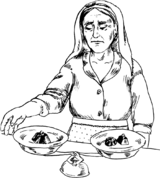
When you treat any health problem, from anemia to too-long labor to heavy bleeding, you must find the treatment that has the most benefits and the least risk of harm.
Benefits and risks
Any time you make a decision about a medical treatment, you should consider the benefits and risks.
A benefit is the good that an action or treatment might bring. A risk is the harm that it might cause. Each time you make a decision, try to choose the action with the most benefit and the least risk.
Think again about Elena and Celeste:
What if Elena’s anemia did not go away after eating more iron-rich foods and taking iron pills? She and Celeste would have to make a difficult decision.
Celeste knows that a woman with severe anemia is probably safer giving birth in a well-equipped medical center than at home. This way, if severe bleeding happens, a blood transfusion is immediately available. Without this care, Elena might be very weak after the birth. This weakness will make her more likely to get an infection. It will make it very hard for her to care for her family and herself. And if a baby’s mother is not able to care for him well, he may be in danger too.
On the other hand, most women in the village have anemia. And most of them will not have serious problems after their births. The hospital is a day’s journey away and very expensive. Elena’s family would have to spend most or all of their money for her to give birth there.
Staying home and going to the hospital each have benefits and risks. What would you do?
Medicines in particular have both benefits and risks. Even a medicine that is very helpful for treating a health problem may have side effects or dangers. In this book, there are procedures and medicines that have very serious risks. We include them because when they are truly necessary, they can save lives. But before giving any medicine or doing any invasive (inside the body) procedure, including emergency procedures like removing the placenta by hand or MVA, you must decide if you can do it safely — with more benefit than risk.
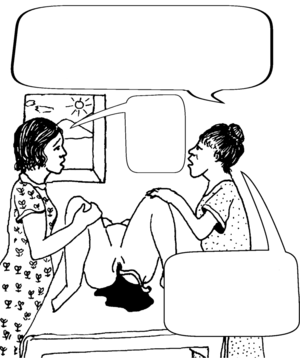 We must get her to the hospital right away! They can reach inside to take the placenta out and stop the bleeding.
Why can't you do it?
It is much too dangerous! It is safer in the hospital. |
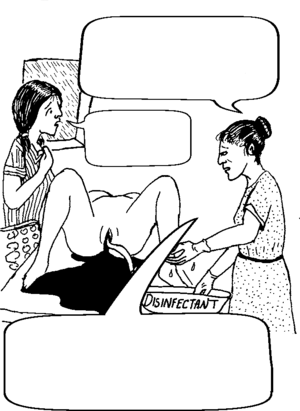 I am going to have to reach inside to get the placenta out.
Isn't that dangerous?
Yes, very! But the road is washed out by the rain—and there is no way to get help before she bleeds to death. |
Types of medicine
Around the world, people use many different ways of healing:

- Traditional medicine (also called folk medicine): These ways of healing have been passed down from older healers to younger ones for many generations. Traditional ways of healing use massage, plant medicines, and communication with the spiritual world.
Traditional medicines, particularly home remedies, can be very effective. They are often the safest, easiest, and least costly treatments for most health problems. And when money runs out, or outside aid groups leave, the plants, massage techniques, and other traditional ways of healing will still be here.
Many traditional medicines have been tested using science. Testing has shown that some traditional medicines work well and others do not, or they only work because people’s belief in them is strong. Some traditional medicines are harmful or dangerous. - Western medicine: This system of healing relies on scientific testing, manufactured medicines (drugs), and surgery to treat health problems.
- Non-Western systems like acupuncture, ayurveda, or homeopathy: These systems of healing may have been used for thousands of years, are taught in books and schools, and may have been tested using science. Many of these systems also use plant medicines.

One person may use several of these ways of healing.
There is not enough space in this book to fully describe every system of healing. What is important to remember is that each type of healing has benefits, and that any kind of medicine must be used with care.
Western medicine
Western medicine, when used correctly, can save lives. And Western medicine is usually the best treatment for emergencies. For example, when a woman is bleeding heavily after a birth, there may be plant medicines in your area that can slow her bleeding. But Western medicines often work better and more quickly — they are more sure to save a bleeding woman’s life.
Use Western medicines correctly
Most Western medicines have been carefully tested by science. Western medicine is usually very effective at treating problems. But Western remedies are often expensive, some have side effects, and in many cases they are not necessary. Most basic health problems could be treated just as well with traditional or home remedies, or just by waiting.
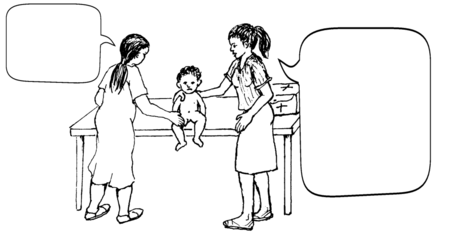
is a cold. Let him rest, give him good food and lots to drink. Strong medicine won't help and might even
harm him.
Using any medicine when it is not necessary, or using too much, can cause serious health problems. For example, some people believe that only an injection will help them when they are sick. These people would usually get better if they did nothing, and in many cases, unnecessary injections have caused abscesses or have passed disease (like HIV) when given with unsterilized needles. So although medicines can save lives, they must be used correctly.
This book is mostly about Western medicine
This book mostly teaches how to use Western methods of healing. There is one main reason for this: Western medicines are available in most parts of the world. We do not know enough, nor do we have enough room to explain how to use the millions of traditional plants and ways of healing that are used around the world. Therefore, please use the back of this book to write down the traditional methods that you use. And if you translate or adapt this book, be sure to include your local ways of healing. It is very important to share these traditional ways of healing so that they are not forgotten!
Choosing a medicine that is safe and helpful
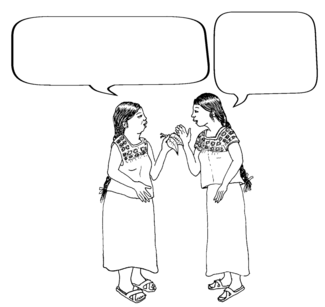
Before you give a medicine (traditional or Western), you should be confident that it is safe and helpful. To know if this is true, think about (and ask others) these questions:
- What is it used for?
- What happens when you use it?
- How often does it help make a problem better?
- What side effects or other problems does it cause?
When you are trying a treatment for the first time, use it alone, not mixed with other treatments. That way you will know if it works, and if it causes problems. Learn more about using medicines safely.
Medicine and greed
Sadly, some healers and health workers are motivated by greed. In order to make money, they may recommend a treatment that is not necessary, that does not work, or even one that is dangerous. Some healers rely on the respect others have for them to sell potions or medicines that do not really work.

Some companies that make and sell medicines use their reputations to mislead, too. When drug companies act in this way, whole communities can be put in danger. For example, a US drug company named Eli Lilly used to make a medicine called diethylstilbestrol (DES). DES was supposed to help prevent miscarriages. In fact, DES did not prevent miscarriages. It caused birth defects and cancer. Eli Lilly knew that the drug might cause these problems but kept selling it anyway. And even after the drug was made illegal in the US, it was still sold in other countries.
Know your limits
Know when to do nothing
In this book, we talk mostly about how to solve health problems. This is important. But in many cases, the best thing to do for a woman in labor is nothing! A woman who is healthy is likely to have a healthy and happy birth. Most births go well.
Doing unnecessary procedures can cause serious problems. Respect the process of birth. When all is going well, simply watch and wait.
Know when to get help
No matter how skilled you are, there will be times when you need help. Knowing when to get medical advice, when to enlist the support of another midwife, or when to send a woman to a doctor or medical center, is a skill that every midwife must try to master.
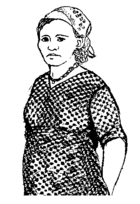
It can be hard to know when to get medical help. Hospitals and medical centers are often expensive or far away. Many women are afraid to go to them. A woman with a small problem may want to stay home. She may not want to go to a medical center unnecessarily. But if she stays at home without help, the problem could get much worse.
If you know a woman is having a problem like hemorrhage, infection, or pre-eclampsia, do not delay — get medical help. The sooner you go, the better her chances of recovery. Sometimes you may have to rush, sometimes you may not. If labor is long, for example, and you live and work very far from a medical center, you must start your journey early, before the problem is serious. If the medical center is only across the road, you have more time.
Know when to take action at home
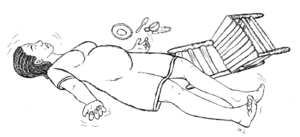
Midwives who work very far from medical care must also sometimes give treatments that are better done in a medical center or hospital — because the woman needs the treatment right away. For example, if a woman in an isolated village has a seizure from eclampsia, her midwife should give her magnesium sulfate, a drug that is not usually safe to give at home. Then the midwife should take the woman to a medical center right away, because both the seizure and the magnesium sulfate are very dangerous.
WARNING! In this book, we explain how to do some procedures that can be dangerous if they are not done correctly, such as: how to do a pelvic exam, how to insert an IUD, or how to sew a tear. It is not enough to read about these procedures. Before you do many of the procedures in this book, first watch other experienced health workers doing them. Then practice while someone with experience and training watches and helps you. Only after you have practiced many times in this way is it safe for you to do these procedures on your own.


